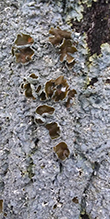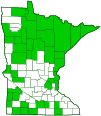Brown-eyed Rim Lichen
(Lecanora allophana)
Conservation • Description • Ecology • Distribution • Taxonomy
Conservation Status |
|
|||||||
| IUCN Red List | not listed |
|||||||
| NatureServe | NNR - Unranked |
|||||||
| Minnesota | not listed |
|||||||
Description |
||
Brown-eyed Rim Lichen is a common, distinctive, crust-like (crusticose) lichen. It occurs in Europe and North America. In the United States, it occurs in the east from New Hampshire to North Carolina, west to Minnesota and Illinois. There are also disjunct populations in Colorado, Washington, and California. It grows on the bark and wood of both deciduous and coniferous trees, but especially on poplar and ash. The vegetative body (thallus) is crust-like (crusticose) and quite variable. It is composed of tiny granules, like grains of sugar. This is best seen with magnification of a 10x lens. It may be continuous or sharply divided into islands separated by cracks (areolate). The areoles may be thick or thin, and they may be flat or be covered with small, wart-like elevations (verruculose). The surface may be smooth or rough. The color may be yellowish white to yellowish gray or whitish gray to gray. As it ages, it may develop granular asexual reproductive structures (soredia), or these may be absent. When soredia are present, the areas where they are formed (soralia) may be white to whitish gray or pale yellow to yellowish gray. Spore-bearing reproductive structures (apothecia) are common. They are disk-like and large, 1⁄32″ to ⅛″ (0.6 to 2.5 mm) in diameter. They are almost always constricted at the base causing them to appear almost stalked. The discs are distinctly reddish brown and flat. They are not covered with a whitish or grayish powdery bloom (epruinose). The disc margins are persistent, and they are the same color as the thallus. They may be thin or relatively thick. They may be smooth to slightly finely scalloped, but they are often wavy, or zigzagged. |
||
Similar Species |
||
Ecology |
||
Substrate |
||
Trees |
||
Growth Form |
||
Crusticose |
||
Habitat |
||
Bark |
||
Hosts |
||
Hardwood trees, especially on poplar and ash |
||
Distribution |
||||
|
Sources This map includes only records from sources that do not accept the synonymy of Lecanora allophana and Lecanora albella. |
|||
| 1/24/2023 | ||||
Occurrence |
||||
Common |
||||
Taxonomy |
|||
| Kingdom | Fungi (Fungi) | ||
| Subkingdom | Dikarya | ||
| Phylum | Ascomycota (Sac Fungi) | ||
| Subphylum | Pezizomycotina (Sac Fungi and Lichens) | ||
| Class | Lecanoromycetes (Common Lichens) | ||
| Subclass | Lecanoromycetidae (Shield Lichens, Sunburst Lichens, Rosette Lichens, and Allies) | ||
Order |
Lecanorales (Shield Lichens, Rim Lichens, and Allies) | ||
Family |
Lecanoraceae (rim lichens, disc lichens, and allies) | ||
Genus |
Lecanora (rim lichens) | ||
| Mycobiont | Lecanora allophana | ||
| Photobiont | |||
Lecanora allophana was originally described by Erik Acharius in 1809. In 1855, William Nylander published a major work on Scandinavian lichens where he treated Lecanora allophana as a synonym of Lecanora albella, which was originally described by Christiaan Hendrik Persoon in 1794. The synonymy is broadly accepted, but there is still some debate among lichenologists. Some argue that minor morphological differences might justify maintaining Lecanora allophana as a distinct species or variety. The most significant morphological feature distinguishing Lecanora albella is the dense whitish powdery (pruinose) bloom on the upper surface of the apothecia, which is absent from Lecanora allophana. Sources that accept the synonymy of the two species include Index Fungorum, GBIF, and Catalog of Life. Sources that do not accept the synonymy include MycoBank, MycoPortal, Consortium of Lichen Herbaria, Mushroom Observer, ITIS, NCBI, USDA PLANTS, NatureServe, and iNaturalist. |
|||
Synonyms |
|||
Lecanora subfusca Lecanora subfusca var. allophana |
|||
Common Names |
|||
Brown-eyed Rim Lichen |
|||
Glossary
Areolate
In mushrooms, the cap surface cracked creating block-like patches similar to dried mud. In lichens: the surface sharply divided into islands separated by cracks.
Apothecium
An open, disk-shaped or cup-shaped, reproductive structure, with spore sacs on the upper surface, that produces spores for the fungal partner of a lichen. Plural: apothecia.
Crusticose
Crusty; referring to lichens in such close contact with the rock surface (substrate) that it appears sprayed on like paint.
Soredium
An asexual reproductive structure of a lichen in the form of a tiny dull granule on the thallus surface that can be easily brushed off. It consists of a cluster of algal cells (the photobiont) wrapped in fungal filaments (the mycobiont), but without an outer layer of protective tissue (cortex). Plural: soredia.
Thallus
In lichens: The vegetative body of a lichen composed of both the alga and the fungus. In liverworts: a flat, relatively undifferentiated plant body. Plural: thalli.
Visitor Photos |
|||||
Share your photo of this lichen. |
|||||
| This button not working for you? Simply email us at info@MinnesotaSeasons.com. Attach one or more photos and, if you like, a caption. |
|||||
Luciearl |
|||||
 |
|||||
MinnesotaSeasons.com Photos |
|||||
|
|||||

Slideshows |
||

Visitor Videos |
|||
Share your video of this lichen. |
|||
| This button not working for you? Simply email us at info@MinnesotaSeasons.com. Attach a video, a YouTube link, or a cloud storage link. |
|||
Other Videos |
|||

Created: 1/25/2024
Last Updated:


